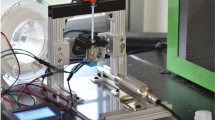Abstract
In injection molding process, the mold temperature can strongly affect the fiber orientation and distribution state in plastic parts. The fiber orientation behavior is discussed, and a model is used to describe the layered structure in injection parts. By studying the injected specimens, the fiber distribution and the layered structure in the part are illustrated and a variation of the fiber distribution along with the increasing of the mold temperatures is also demonstrated. The surface morphologies of the fiber-reinforced specimens at different mold temperatures are analyzed which are used to study the effect of the mold temperature on the fiber motion process of the resultant parts. Results show that in proper mold temperature, the fibers can be completely covered in polymer matrix and the mold temperature can greatly affect the part surface quality.
Similar content being viewed by others
References
Kang ST, Kim JK (2012) Numerical simulation of the variation of fiber orientation distribution during flow molding of ultra high performance cementitious composites (UHPCC). Cem Concr Compos 34(2):208–217
Dong C (2014) Experimental investigation on the fiber preform deformation due to mold closure for composites processing. Int J Adv Manuf Technol 71(1-4):585–591
Hashemi S, Lepessova Y (2007) Temperature and weldline effects on tensile properties of injection moulded short glass fibre PC/ABS polymer composite. J Mater Sci Res 42(8):2652–2661
Köpplmayr T, Milosavljevic I, Aigner M, Hasslacher R, Plank B, Salaberger D, Miethlinger J (2013) Influence of fiber orientation and length distribution on the rheological characterization of glass-fiber-filled polypropylene. Polym Test 32:535–544
Işık B (2008) Experimental investigations of surface roughness in orthogonal turning of unidirectional glass-fiber reinforced plastic composites. Int J Adv Manuf Technol 37(1-2):42–48
Agboola BO, Jack DA, Smith SM (2012) Effectiveness of recent fiber-interaction diffusion models for orientation and the part stiffness predictions in injection molded short-fiber reinforced composites. Compos Appl Sci Manuf 43(11):1959–1970
Serrano A, Espinach FX, Julian F, Rey R, Mendez JA, Mutje P (2013) Estimation of the interfacial shears strength, orientation factor and mean equivalent intrinsic tensile strength in old newspaper fiber/polypropylene composites. Compos B Eng 50:232–238
Jeffery G (1923) The motion of ellipsoidal particles immersed in a viscous fluid. Proc R Soc Lond A 102:161–179
Agboola BO, Jack DA, Stephen MS (2012) Effectiveness of recent fiber-interaction diffusion models for orientation and the part stiffness predictions in injection molded short-fiber reinforced composites. Compos Appl Sci Manuf 43(11):1959–1970
Montgomery-Smith SJ, Jack D, Smith D (2010) A systematic approach to obtaining numerical solutions of Jeffery’s type equations using spherical harmonics. Compos Appl Sci Manuf 41:827–835
Montgomery-Smith SJ, He W, Jack D, Smith D (2011) Exact tensor closures for the three dimensional Jeffery’s equation. J Fluid Mech 680:321–335
Yamanoi M, Maia JM (2010) Analysis of rheological properties of fiber suspensions in a Newtonian fluid by direct fiber simulation. Part 3: behavior in uniaxial extensional flows. J Fluid Mech 165(23–24):1682–1687
Shokri P, Bhatnagar N (2012) Effect of the post-filling stage on fiber orientation at the mid-plane in injection molding of reinforced thermoplastics. Phys Procedia 25:79–85
Meyer KJ, Hofmann JT, Baird DG (2013) Initial conditions for simulating glass fiber orientation in the filling of center-gated disks. Compos Appl Sci Manuf 49:192–202
Tzeng CJ, Yang YK, Lin YH, Tsai CH (2012) A study of optimization of injection molding process parameters for SGF and PTFE reinforced PC composites using neural network and response surface methodology. Int J Adv Manuf Technol 63(5–8):691–704
Chen CS, Chen TJ, Chen SC, Chien RD (2011) Optimization of the injection molding process for short-fiber-reinforced composites. Mech Compos Mater 47(3):359–368
Ertas AH (2013) Optimization of fiber-reinforced laminates for a maximum fatigue life by using the particle swarm optimization. Part I. Mech Compos Mater 48(6):705–716
Shie J (2008) R (2008) Optimization of injection molding process for contour distortions of polypropylene composite components by a radial basis neural network. Int J Adv Manuf Technol 36:1091–1103
Yashiro S, Sasaki H, Sakaida Y (2012) Particle simulation for predicting fiber motion in injection molding of short-fiber-reinforced composites. Compos Appl Sci Manuf 43(10):1754–1764
Lutz W, Herrmann J, Kockelmann M, Hosseini HS, Jackel A, Schmauder S, Predak S, Busse G (2009) Damage development in short-fiber reinforced injection molded composites. Comput Mater Sci 45:698–708
Launay A, Maitournam MH, Marco Y, Raoult I (2013) Multiaxial fatigue models for short glass fibre reinforced polyamide. Part II: fatigue life estimation. Int J Fatigue 47:390–406
Author information
Authors and Affiliations
Corresponding author
Rights and permissions
About this article
Cite this article
Li, XP., Zhao, GQ. & Yang, C. Effect of mold temperature on motion behavior of short glass fibers in injection molding process. Int J Adv Manuf Technol 73, 639–645 (2014). https://doi.org/10.1007/s00170-014-5874-8
Received:
Accepted:
Published:
Issue Date:
DOI: https://doi.org/10.1007/s00170-014-5874-8




